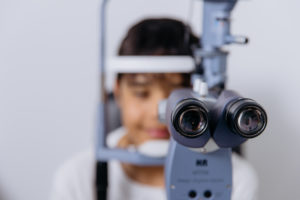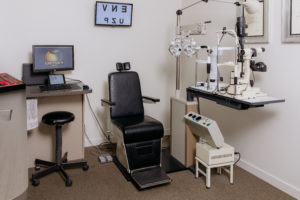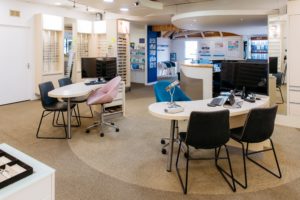February 15, 2023
By Jagrut Lallu, BOptom, MSc
In 2009, most optometrists and ophthalmologists were not open to myopia management despite growing evidence. Only about 400 peer-reviewed papers were published on the subject at the time.

Dr. Lallu’s main priority is ensuring his patients receive the proper myopia management care.
The title of this article may seem like science fiction, but this is how it felt in 2009 when we created the first myopia management clinic in New Zealand. Colleagues and patients alike said, “What are you talking about?”
A little about my background first. In 2008, I was awarded a scholarship from the Snowvision Foundation, which had an annual prize for a trip to the SUNY College of Optometry to learn about optometry in the U.S. with colleagues such as Drs. David Troilo, Sherry Bass, Richard Madonna, and Jerome Sherman. As a final-year optometry student, one of the application questions was: “What will the future hold for the profession?” My response was: “Within the next ten years, myopia progression control will be part of clinical practice as a standard of care, and optometrists in New Zealand will have glaucoma prescribing rights.”
I am pleased to say that optometrists in New Zealand have glaucoma prescribing rights. I may have been too optimistic about the minimum standard of care for myopic children. However, we are getting VERY close.
Why Mars?
In 2009, most optometrists and ophthalmologists were not open to myopia management despite growing evidence. At the time, orthokeratology was deemed unsafe before anyone would discuss its potential as a treatment for childhood myopia.
After graduating from optometry school, I was lucky that my first position was with Rose Optometry in Hamilton, New Zealand, a practice renowned for innovation (Home of the Rose K lens and Paul Rose). When I began, I asked my bosses at the time (Simon Rose and Peter Walker) whether I could set up an OrthoK and myopia management clinic. They immediately replied yes. So, I self-funded and sent myself to John Mountford to learn how to fit OrthoK. I also got involved with the Cornea and Contact Lens Society of New Zealand and the Orthokeratology Society of Oceania. I began to read as many papers as possible on OrthoK and myopia management. Only about 400 peer-reviewed papers were published on the subject at the time.
From there, I wrote letters to all ophthalmologists near me and around New Zealand and called every sports club and school in the region (120 ophthalmologists and 300 clubs in the community) to advise them of this clinic update. I am very grateful to a pediatric ophthalmologist local to our clinic, Dr. John Dickson, who was open to myopia management. Back then, he and the entire group of ophthalmologists at Hamilton Eye Clinic allowed us to send patients to their facilities for axial length measurements.
Initially, they offered to do this at no charge. However, we decided they needed to charge us as we did not want to cause contention or dissent with other optometrists. This model worked well in getting started and is probably a good pearl.
Certain colleague ophthalmologists rubbished the idea of myopia management, and they shall remain nameless. It is my hope now, with the wisdom of hindsight, that these colleagues have slightly altered their view. Today, one of the most critical success factors of our myopia management clinic has been the joint support and approach from ophthalmology. New Zealand’s Cornea and Contact Lens Society was the first society of its kind in the world (established in 1958) and enjoys strong collegiality between ophthalmology and optometry.
 |
 |
Dr. Lallu’s practice is designed to best care for his myopia management patients.
Adopting Treatment Modalities
The method of management for myopia that united both parties was the evidence from the Singapore Eye Research Institute around the use of topical low-dose atropine. Since then, our knowledge of low-dose atropine has evolved. However, at the time, the protocol was to prescribe 0.01% for two years, have a break for a year, and then resume for another two years. For many children, this protocol worked well. We initiated combination treatment with OrthoK, despite lacking scientific evidence. We co-managed these children with ophthalmology.
In 2010, our clinic gained access to a newly designed soft contact lens for myopia progression control from the University of Auckland School of Optometry called MiSight. I jumped at the chance to try this new product to manage childhood myopia. This lens has proven to be a great addition to our myopia management armamentarium.
Working with Local Practitioners
Establishing relationships with local practitioners and the hospital has been vital to growing our myopia management clinic. We have met with all of our local optometric practitioners and provided updates to them about our clinic. This update happens annually.
Suppose a child has been examined at a practice that does not offer myopia management. In that case, we offer a co-management service where the practitioner can refer them to us for myopia management only. The child’s prescription eyewear recommendation will be sent back to the referring optometrist to be filled. Following this protocol, we have built high-trust, quality relationships with our competitors.
One example of supporting each other is as follows: A direct competitor practice had a topographer break down. It was going to be ten weeks before a new one would arrive. This practice is a group practice and heavily relies on this one piece of equipment. To help them with their continued patient care, we loaned them one of our units (we have a topographer in each consulting room). Relationships are built by looking at care and not profit, and together we can work to address the myopia epidemic.
Things that I am working on today are:
- The establishment with our FDA equivalent of the approval to supply multivariate doses of atropine under prescription to increase access to myopia management.
- Advocating with our board in New Zealand to mandate the minimum standard of care for pediatric myopes is myopia management, e.g., the promotion of the idea that it is negligence to prescribe single vision distance when there is overwhelming evidence for public safety and the reduction of myopic sequelae by implementing myopia management. As a clinic, we are open to educating anyone who wishes to get into the field and support their growth.
- The most straightforward message at a fundamental level that we are promoting to all patients is more green, less screen, and patients who are myopic and progressing or at risk do not get any choice but to receive myopia management with a suitable explanation. As a result, we receive regular referrals from local practitioners. (General medical practitioners, ophthalmologists, optometrists, and pediatricians)
- We are working very hard on education, and Jacqueline Rowe is in charge of this within our practices to educate our front office team and optometrists. When I first graduated, I used to sleep four hours per night and thought I could do this all by myself. I have learned that we need strong leaders and teams around us to all move together. We are proud of what we are doing in our little corner of the world, and we’d love the profession to join us to break more boundaries in this subspecialty area.
Critical learnings for those wanting to set up a new clinic:
- Passion — be passionate about myopia management to prevent future eye health issues.
- Tell everyone — share your clinic with as many people in the community as you can: ophthalmologists, optometrists, schools, and pediatricians.
- Expect negativity and rejection — for many reading this, it won’t be disappointing, given that myopia management is more known now. Imagine what it was like when everyone thought we were crazy. The evidence is sound; keep plugging away and stay positive.
- Try things until they work — keep trying to crack the nut in your area until you gain some traction. A snowball always starts as a snowflake.
- Seek mentorship and support — reach out to any of us who have been doing it for awhile, as we are all willing to support your growth and journey. We do this because we recognize that we can’t do this alone; we need to solve this together. All ophthalmic companies have a vested interest in making myopia management succeed.
 |
Jagrut Lallu joined the Rose Optometry practice in Hamilton, New Zealand, in February 2009. He has a special interest in myopia management and keratoconus fitting. Currently, he is a clinical senior lecturer at Deakin University and a Teaching Fellow at the University of Auckland. Jagrut is the Past President of the Cornea and Contact Lens Society of New Zealand and served ten years on the Orthokeratology Society for Oceania as the New Zealand Liaison. Jagrut Lallu can be reached at: jlallu@roseoptom.co.nz |













